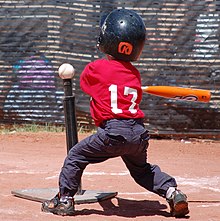Teacher Stories
Submitted on November 18, 2011 by Timothy Boyle

During most of my time as a science teacher I created an experiential learning environment for my students. I would throw up my focus question, explain the materials and how to use them, and let the kids go. I developed some good instincts for when kids might get stuck on something, and more importantly when to let students figure something out on their own. After three years I knew when to be the tee, and when to be the pitch.
When you start playing baseball, you hit off of a tee. The tee holds the ball in place so that a hitter has a chance to practice making contact with it. We use tees because little kids need a lot of scaffolding to learn how to hit. This won’t happen if there was a pitcher. Expecting a five year old to throw strikes to another five year old is unrealistic. Children at this age lack the motor skills and general body control needed to pitch with any consistency.
Additionally the defensive players won’t learn how to field either. If a kid is walking every child, the fielders won’t learn what to do if a ball is hit to them. It is beneficial to all involved that the difficult aspects of the game are made easier. People don’t like to play a game that is too hard for them.
When students in my class used a balance for the first time to measure the force of attraction, I needed to go over how to set-up and use this tool. Letting students get bad data, because they didn’t know how to use a balance would be asking for failure. The bar to success on this lesson had to be approachable. It made sense for my students to have a tee.
After kids get plenty of practice playing baseball, they start to refine their motor skills. When this happens, it is time for the kids to start facing some pitching. It is important to let kids have an authentic experience when they are ready for the challenge not when they are advanced at a skill. No one gets better at baseball by just practicing; you have to play the game.
Once students have learned to light a bulb, you don’t have to spend any time explaining to them how to get a motor running. Students may never have held a motor in their hands, but they have had an experience with making a circuit. This is where the pitch comes in. I don’t need a kid to know how to do everything before they do it; I just need them to relate new information to what they already know.
Teaching writing for the first time, I quickly realized that I wasn’t sure about when to be the tee or when to be the pitch. Sometimes I feel like I spend a whole class period being either just the pitch or just the tee. Sometimes I feel like I am jumping between the two, to the confusion of my students and myself.
There is much for me to learn in this new position. I knew that my students can write and they have had a variety of writing experiences. I don’t have to scaffold every writing concept for them. I certainly don’t have to wait for every student to be “proficient” at any number of writing skills before I can expect them to create original narratives or expository pieces.
As I adjust to this new assignment, I have been thinking lately that new is less a time and more a way of reacting to a situation, a lens. When you can’t relate to what is going on, you have to make it up as you go, sometimes to poor results. When you understand what you are doing, you can relate it back to what has worked for you in the past.
Being new to my current position, I am feeling uncomfortable. I’ve definitely fallen victim to operating under the lens of new. I’m hoping that for the rest of the year, I can limit my reactions to using this “new” lens. Instead I want to think about how what I’m doing today reminds me what I’ve done successfully in the past.
I’m hopeful there will be a lot more breaths followed by “this reminds me of…” as the year goes on.